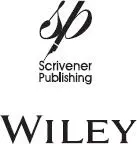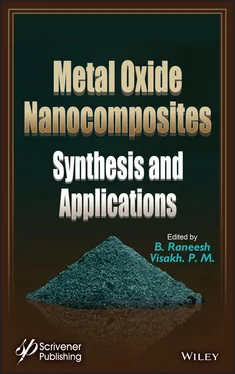Metal Oxide Nanocomposites
Здесь есть возможность читать онлайн «Metal Oxide Nanocomposites» — ознакомительный отрывок электронной книги совершенно бесплатно, а после прочтения отрывка купить полную версию. В некоторых случаях можно слушать аудио, скачать через торрент в формате fb2 и присутствует краткое содержание. Жанр: unrecognised, на английском языке. Описание произведения, (предисловие) а так же отзывы посетителей доступны на портале библиотеки ЛибКат.
- Название:Metal Oxide Nanocomposites
- Автор:
- Жанр:
- Год:неизвестен
- ISBN:нет данных
- Рейтинг книги:5 / 5. Голосов: 1
-
Избранное:Добавить в избранное
- Отзывы:
-
Ваша оценка:
- 100
- 1
- 2
- 3
- 4
- 5
Metal Oxide Nanocomposites: краткое содержание, описание и аннотация
Предлагаем к чтению аннотацию, описание, краткое содержание или предисловие (зависит от того, что написал сам автор книги «Metal Oxide Nanocomposites»). Если вы не нашли необходимую информацию о книге — напишите в комментариях, мы постараемся отыскать её.
Metal Oxide Nanocomposites — читать онлайн ознакомительный отрывок
Ниже представлен текст книги, разбитый по страницам. Система сохранения места последней прочитанной страницы, позволяет с удобством читать онлайн бесплатно книгу «Metal Oxide Nanocomposites», без необходимости каждый раз заново искать на чём Вы остановились. Поставьте закладку, и сможете в любой момент перейти на страницу, на которой закончили чтение.
Интервал:
Закладка:
394 391
395 392
396 393
397 394
398 395
399 396
400 397
401 399
402 400
403 401
404 402
405 403
Scrivener Publishing
100 Cummings Center, Suite 541J
Beverly, MA 01915-6106
Publishers at Scrivener
Martin Scrivener ( martin@scrivenerpublishing.com)
Phillip Carmical ( pcarmical@scrivenerpublishing.com)
Metal Oxide Nanocomposites
Synthesis and Applications
Edited by
B. Raneesh and Visakh P. M.

This edition first published 2021 by John Wiley & Sons, Inc., 111 River Street, Hoboken, NJ 07030, USA and Scrivener Publishing LLC, 100 Cummings Center, Suite 541J, Beverly, MA 01915, USA
© 2021 Scrivener Publishing LLC
For more information about Scrivener publications please visit www.scrivenerpublishing.com.
All rights reserved. No part of this publication may be reproduced, stored in a retrieval system, or transmitted, in any form or by any means, electronic, mechanical, photocopying, recording, or otherwise, except as permitted by law. Advice on how to obtain permission to reuse material from this title is available at http://www.wiley.com/go/permissions.
Wiley Global Headquarters
111 River Street, Hoboken, NJ 07030, USA
For details of our global editorial offices, customer services, and more information about Wiley products visit us at www.wiley.com.
Limit of Liability/Disclaimer of Warranty
While the publisher and authors have used their best efforts in preparing this work, they make no representations or warranties with respect to the accuracy or completeness of the contents of this work and specifically disclaim all warranties, including without limitation any implied warranties of merchant-ability or fitness for a particular purpose. No warranty may be created or extended by sales representatives, written sales materials, or promotional statements for this work. The fact that an organization, website, or product is referred to in this work as a citation and/or potential source of further information does not mean that the publisher and authors endorse the information or services the organization, website, or product may provide or recommendations it may make. This work is sold with the understanding that the publisher is not engaged in rendering professional services. The advice and strategies contained herein may not be suitable for your situation. You should consult with a specialist where appropriate. Neither the publisher nor authors shall be liable for any loss of profit or any other commercial damages, including but not limited to special, incidental, consequential, or other damages. Further, readers should be aware that websites listed in this work may have changed or disappeared between when this work was written and when it is read.
Library of Congress Cataloging-in-Publication Data
ISBN 978-1-119-36357-6
Cover image: Pixabay.Com
Cover design by: Russell Richardson
Set in size of 11pt and Minion Pro by Manila Typesetting Company, Makati, Philippines
Printed in the USA
10 9 8 7 6 5 4 3 2 1
Preface
Recently, there have been a number of research accomplishments in the field of metal oxide nanocomposites and their synthesis and applications, many of which are summarized in this book. Besides discussing the state of the art in the field, new challenges and opportunities regarding their use are also presented. Along with the structure-property relationships of metal oxide nanocomposites, the book also includes introductory material on nanocomposites, graphene-based metal and metal oxide nanocomposites, carbon nanotube–metal oxide nanocomposites, and metal oxide-based nanocomposites. In addition to the application of metal oxide nanocomposites in photocatalysis and sensors, among the other topics presented are thermal analysis of the properties of metal oxide nanocomposites, semiconducting metal oxides for photocatalytic and gas-sensing applications, applications of metal oxide-based nanocomposites, triboelectric nanogenerators (TENG) based on nanocomposites, and metal oxide nanocomposites for water purification. Since this book is an up-to-date record of the major findings and observations in the field—with chapters contributed by prominent researchers from industry, academia and government/private research laboratories across the world—it will act as a very valuable reference source for university and college faculties, professionals, post-doctoral research fellows, senior graduate students, and researchers from R&D laboratories working in the area of metal oxide nanocomposites.
The introductory chapter discusses the scope, state of the art, preparation methods, new challenges and opportunities concerning metal oxide nanocomposites. Chapter 2gives a more detailed review of structure-property relationships. Included in the many topics discussed in this chapter are the functions of fibers and matrix, classification of composites, matrix-based composites, reinforcements, polymer composites, composites processing, product fabrication, application, and special features of composites, along with their advantages and disadvantages compared with metals.
Graphene-based metal and metal oxide nanocomposites are introduced in Chapter 3. In this chapter, the authors discuss graphene, reduced graphene oxide, graphene-based composites and hybrid nanocomposites, mechanics of graphene nanocomposites, covalent and noncovalent functionalization and thermal properties. Chapter 4on carbon nanotube–metal oxide nanocomposites introduces carbon nanotubes, including packaging applications, followed by different topics such as synthesis methods, environmental applications, environmental fate, transport, transformation, and environmental implications; and concludes with the direction that future research might take.
Two main topics are addressed in Chapter 5. The first is nanocomposite photocatalysts based on metal oxide, including those based on TiO 2, ZnO and WOx. The second topic, the application of metal oxide composites in photocatalysis, includes a discussion of water splitting for hydrogen generation, photodegradation of pollutants and wettability patterning based on photocatalysts. Chapter 6is a structural analysis of metal oxide nanocomposites for sensor applications. Following an introduction to the subject matter, the chapter goes on to discuss binding of metal oxide with imidazole and silane, characterizations, absorption and emission characteristics, and sensing mechanisms.
Thermal property analysis of metal oxide nanocomposites is discussed in Chapter 7. In this chapter the authors explain the use of metal and metal oxide nanoparticles in thermal management and synthesis procedures, the mechanism of thermal conductivity enhancement and thermal conductivity modeling of nanofluids. In Chapter 8there is a two-part discussion on the topic of semiconducting metal oxides for photocatalytic and gassensing applications. The first part covers topics such as organic dyes as a major source of water pollution, conventional methods used for dye degradation, advanced oxidation processes, the role electronic structure of semiconducting metal oxide plays in photocatalysis, basic principles of photocatalysis, oxidizing species generation mechanism, semiconductor photocatalysts, kinetic studies of semiconductor photocatalysis and parameters affecting dye degradation. The second part of the chapter covers topics such as the evolution of gas sensors and their necessity, metal oxides as gas sensors, the gas-sensing mechanism of metal oxides and factors influencing sensor performance.
Читать дальшеИнтервал:
Закладка:
Похожие книги на «Metal Oxide Nanocomposites»
Представляем Вашему вниманию похожие книги на «Metal Oxide Nanocomposites» списком для выбора. Мы отобрали схожую по названию и смыслу литературу в надежде предоставить читателям больше вариантов отыскать новые, интересные, ещё непрочитанные произведения.
Обсуждение, отзывы о книге «Metal Oxide Nanocomposites» и просто собственные мнения читателей. Оставьте ваши комментарии, напишите, что Вы думаете о произведении, его смысле или главных героях. Укажите что конкретно понравилось, а что нет, и почему Вы так считаете.












